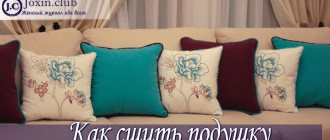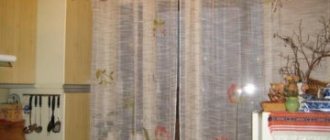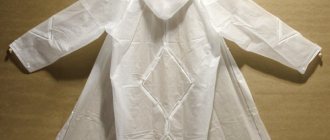Ironing rules for beginners
Basic Rules
■ Fabrics should be ironed predominantly from the wrong side, and best of all - through an ironing iron. ■ The ironing temperature depends on the composition of the fabric fibers; pay attention to the labels; you will learn what they mean in the article on choosing fabric for products. Fabrics and knitted fabrics made of cotton and linen are ironed with a highly heated iron, those made of silk and wool with a moderately heated iron, and those made of chemical fibers with a low-heated iron. Fabrics made from mixed fibers are ironed, focusing on the most sensitive fiber. ■ Be sure to first try ironing on an unnecessary scrap and pay attention to how the fabric reacts to moisture. ■ Fabrics made from linen, cotton and Trevira (a special polyester fibre) and Diolen (a special synthetic fibre) should be ironed damp for best results. Some fabrics will then need to be iron dried completely to avoid creases and waves. Important: completely dry the fabric using an iron. Fabrics with high pile should not be ironed dry to prevent them from becoming shiny. ■ Fabrics made of silk, viscose and acetate fiber can be ironed dry, but with moisture, so the result will be achieved faster. Be careful when ironing through a damp ironing iron: if it is too wet, permanent streaks may remain on the fabric: it is best to iron the ironing iron itself first so that it is only slightly damp. If you iron the fabric with an iron with a humidifier, then use a dry iron. ■ Before cutting, be sure to iron the fabric over the entire area. ■ Iron pieces after each sewing operation and before the next one. For example, the depths of darts before making seams and seam allowances before hemming the bottom; read more about wet-heat treatment during sewing in the master class on WTO. ■ Seam allowances must first be pressed together (picture below),
and then iron it (picture below).
■ Allowances for relief seams in the rounded areas are notched in several places. To iron seam allowances, place the piece on an ironing board so that the seam lies on the rounded edge of the board (picture below), or use an ironing pad.
■ Seam allowances will not be printed on the right side of the fabric if strips of paper are placed under them before ironing (picture below).
■ If, despite all precautions, the seam allowances are printed on the front side of the product, then you need to iron the fabric under the allowances again (picture below). If this is not enough, all that remains is to press the seam allowances together again, and then press them out with extreme care.
■ Darts are ironed to one side or ironed flat. Necklines and other rounded parts should be placed on the ironing mat as they should appear when finished. ■ The seams basted for fitting are ironed only lightly so that there are no hard folds left, otherwise, if alteration is required, these ironed folds may not be completely smoothed out. Basted sections are also ironed only lightly, as basting threads can leave unsightly dents in the fabric. You should not iron over pins either; they not only scratch the sole of the iron, but also leave dents. Before ironing, chalk lines are carefully brushed off. ■ Seams, straight edges and folds should be laid out on the ironing mat after being pressed and flattened. When ironing, the fabric should never be stretched. ■ If shine appears on the fabric during ironing, you can eliminate it by placing a damp iron folded several times over the area and ironing without pressure. You should not iron it dry; you should remove the ironing iron while steam is still emanating from it and run a brush over the fabric. If you iron with a steam iron, then an ironing iron is not needed in this case. Keep the soleplate of the iron close to the shiny area and release more steam. Lightly brush the fabric or hang the product and steam the fabric from the wrong side with a powerful jet of steam, as a result of which the pressed fibers of the fabric will rise and the shine in this area will disappear. ■ Place items ironed with steam in the closet half an hour after ironing - this way you will avoid the formation of mold.
Fabrics are ironed like this
Nylon fabrics
A test ironing of the unnecessary flap with a low-heat iron is required, since these fabrics are extremely sensitive to heat.
Chiffon
Chiffon shrinks when it comes into contact with water, so it cannot be ironed with an iron with a humidifier.
This fabric is ironed with a low-heat iron. Check the iron soleplate for scratches that could damage this delicate fabric. It is best to place a sheet of tissue paper between the iron and the fabric. An iron with a Teflon sole will also work.
Natural silk, including taffeta and crepe satin
Under no circumstances should these fabrics be ironed with moisture, otherwise permanent stains will form. The above-mentioned fabrics are ironed only from the wrong side, through a dry iron, with a moderately heated iron.
Fabrics with long pile
For example, soft drape, camel hair, velor should be ironed exclusively from the wrong side without strong pressure, with steam and without final ironing through a dry cloth, only in this case the pile will not wrinkle.
Cloque and crash effect fabrics
These fabrics cannot be ironed at all. Seam allowances should be smoothed out with your hands or your thumbnail.
Fabrics with metal threads
These fabrics can only withstand very little heat and are afraid of moisture - it makes them matte.
Some ironing accessories
■ Ironing is a fabric for ironing. An ironing iron is necessary when you iron fabric that is particularly sensitive to heat from the front side. Transparent cotton cambric is very convenient: the area being ironed is clearly visible through it, and no folds or wrinkled areas are formed during ironing. If you have an iron without a humidifier, then this fabric can be moistened. A damp cloth will also be needed to iron some types of interlining, as an iron with a damper is not suitable for this purpose.
■ The sleeve ironing board is used for ironing the sleeve and ironing all other small parts that cannot be stretched onto a large board. An ironing pad is convenient for ironing rounded seams and sleeve set-in seams - they come in different sizes. The most convenient one is a small pad that can be put on a sleeve board (see picture above). ■ The steam brush instantly gives shirts, jackets and trousers a well-groomed look and smoothes out wrinkles.
■ The ironing press instantly irons large pieces of fabric and items such as tablecloths, curtains, etc. The fabric can be placed in a press, folded in several layers. The press is very practical for ironing pleats at the waist of products and pleating skirts, for example, for sewing a swing dress pattern. It is also suitable for ironing non-woven fabrics. Allows you to steam wool and cotton fabrics before cutting so that they shrink. ■ And finally, an iron with a temperature regulator is an indispensable tool for sewing work. The best iron is a steam one. They can be ironed with or without moisture. The iron must have a smooth sole. To avoid scratches, do not place the iron on rough surfaces or iron fabric pieces that have been pinned. Under no circumstances should you scrape the soleplate of the iron with a knife. To clean the iron, you need to use a special cleaner or product for the care of metal objects that does not contain abrasives. If the iron is slightly dirty, you can wipe it with an aqueous solution of vinegar. ■ The removable Teflon sole, which is attached to the iron, is very convenient. The Teflon sole not only protects the base sole, but also prevents the formation of gloss spots when ironing. However, it is not a replacement cloth for ironing very sensitive fabrics.
Photo: BurdaStyle.ru











